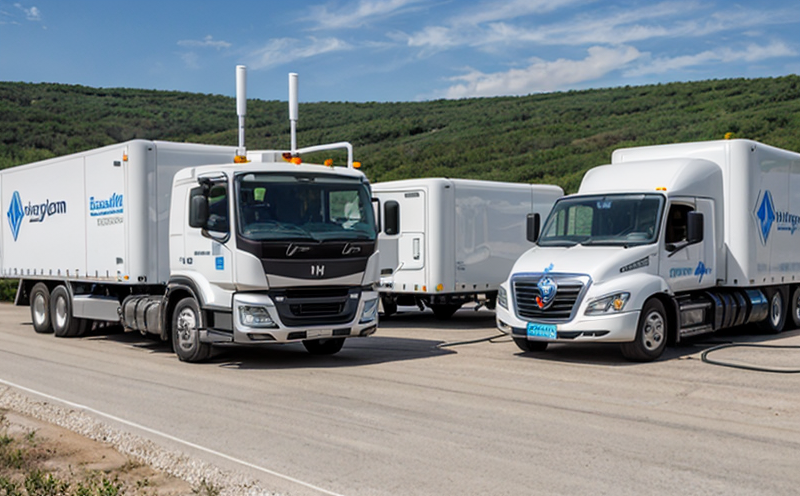ISO 16110-2 Hydrogen Generator Safety Testing
The ISO 16110 series of standards is pivotal in ensuring the safety and quality of hydrogen generators used across various industrial applications. This standard specifically addresses the requirements for the design, production, testing, and certification of hydrogen generators to ensure they meet stringent safety criteria as per international best practices.
Hydrogen generators are critical components in modern energy systems, particularly those transitioning towards renewable energy sources such as wind and solar power. These devices convert electrical energy into hydrogen through electrolysis processes. The production of hydrogen is a key step for fuel cells and other technologies that enable the efficient storage and utilization of intermittent renewable energy.
Compliance with ISO 16110-2 ensures that these generators are robust, reliable, and safe to operate under varying conditions. This standard covers testing procedures aimed at identifying potential hazards such as leaks, pressure surges, and electrical failures which could compromise the safety of personnel and equipment during operation.
The testing process involves a series of rigorous checks designed to simulate real-world operating scenarios. These tests include but are not limited to endurance stress tests, leak detection protocols, and voltage stability assessments. By adhering strictly to these procedures, manufacturers can ensure their products meet or exceed the stringent safety requirements set forth by ISO 16110-2.
For quality managers and compliance officers responsible for ensuring product integrity within organizations involved in hydrogen production facilities or fuel cell technology research and development, compliance with this standard is essential. It provides a framework that helps maintain high standards of reliability while also fostering innovation through structured testing methodologies.
R&D engineers working on next-generation electrolyzer technologies will find value in understanding the nuances of ISO 16110-2 as it offers insights into how existing safety practices can be integrated into new designs. Additionally, procurement teams looking to source reliable hydrogen generators would benefit from familiarity with this standard since certification according to these guidelines indicates adherence to global quality benchmarks.
In summary, compliance with ISO 16110-2 is crucial for any organization involved in the production or deployment of hydrogen generators. Not only does it enhance operational safety but also supports sustainable practices within the broader context of renewable energy utilization.
Applied Standards
| Standard Reference | Description |
|---|---|
| ISO 16110-2:2017 | Hydrogen generators - Safety requirements and testing methods for hydrogen production systems. Particular emphasis on safety aspects related to the design, production, testing, and certification of hydrogen generators. |
| ISO 13702:2005 | Hydrogen fuel cell systems - Safety requirements. Provides additional context on safety considerations beyond those specified in ISO 16110-2. |
| ISO 15154:2010 | Electrolysis systems for hydrogen production - Requirements and testing. Relevant for understanding the broader context of electrolytic processes. |
The application of these standards ensures that hydrogen generators are not only safe to operate but also contribute positively towards environmental sustainability goals by facilitating efficient energy conversion technologies.
International Acceptance and Recognition
The recognition and adoption of ISO 16110-2 extend across multiple industries globally, making it a cornerstone for hydrogen generator safety. Organizations worldwide have embraced this standard due to its comprehensive approach towards identifying potential risks associated with hydrogen production systems.
A significant advantage lies in the harmonization that these standards provide among different countries and regions. This alignment fosters greater collaboration between nations involved in renewable energy projects, thereby accelerating advancements in technology while maintaining consistent safety protocols.
Moreover, adherence to such internationally recognized standards enhances market access for manufacturers by demonstrating commitment to high-quality manufacturing practices. Certification according to ISO 16110-2 can serve as an assurance to potential buyers that the product meets stringent international quality and safety benchmarks.
In conclusion, the acceptance of this standard underscores its importance in promoting a safer hydrogen economy. By ensuring consistent application across borders, it supports global efforts towards reducing carbon emissions through cleaner energy solutions.
Competitive Advantage and Market Impact
Compliance with ISO 16110-2 offers several competitive advantages that can significantly impact market performance. Firstly, it enhances brand reputation by showcasing a commitment to safety and quality assurance. This is particularly important in an industry where public perception plays a crucial role in consumer trust.
Secondly, compliance helps reduce liability risks associated with product failures or accidents. By ensuring that hydrogen generators meet the highest international standards for safety, companies can mitigate potential legal challenges stemming from non-compliance.
Thirdly, adherence to these standards opens doors to new markets and partnerships internationally. Many countries have regulations mandating compliance with certain global standards before approving specific products into their marketplaces. Achieving certification according to ISO 16110-2 can facilitate smoother entry into such jurisdictions.
Lastly, it positions companies as leaders in innovation within the hydrogen generator sector by integrating state-of-the-art safety features into their designs. This leadership role not only attracts more investment but also encourages continuous improvement based on best practices recommended by these standards.
In summary, compliance with ISO 16110-2 is essential for maintaining a competitive edge in today's rapidly evolving hydrogen economy. It provides a robust foundation upon which companies can build trust, reduce risks, expand markets, and lead technological advancements.





